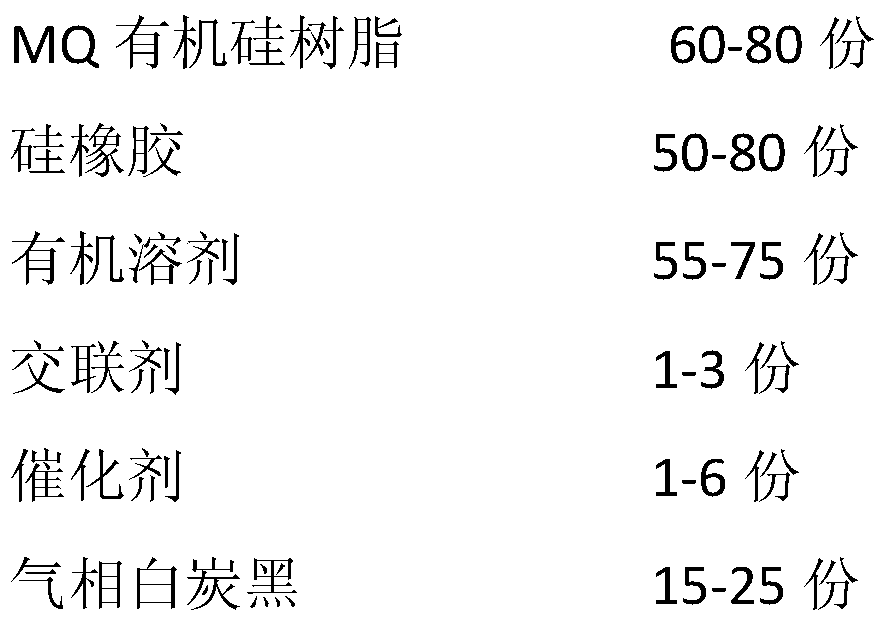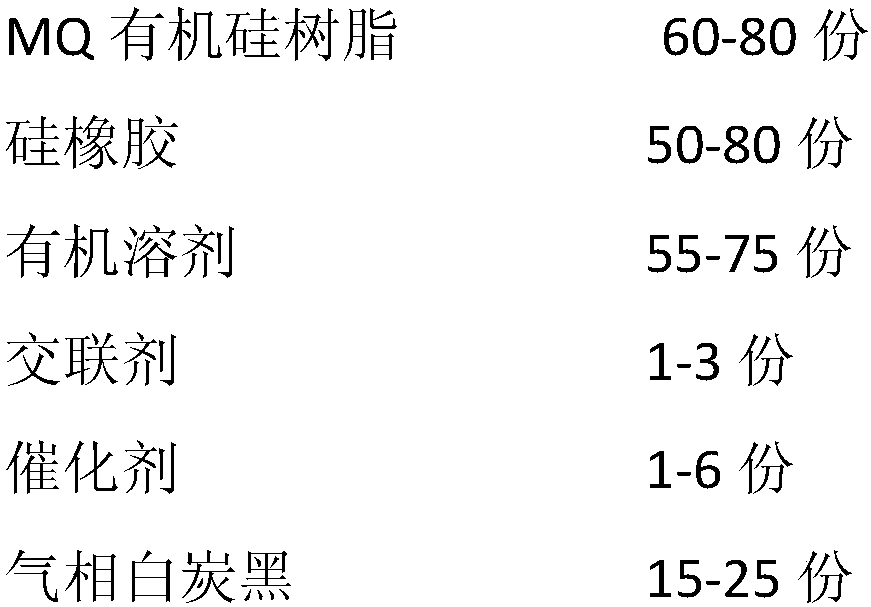A kind of self-adhesive high temperature resistant release cloth and preparation method thereof
A technology with high temperature resistance and self-adhesiveness, applied in chemical instruments and methods, adhesives, non-polymer adhesive additives, etc., can solve problems such as reduced coating adhesion, hidden dangers caused by fire safety, and product quality decline
- Summary
- Abstract
- Description
- Claims
- Application Information
AI Technical Summary
Problems solved by technology
Method used
Image
Examples
preparation example Construction
[0029] According to the present invention, the preparation method of the silicone pressure-sensitive adhesive includes the following steps: adding organic solvent, MQ silicone resin and silicone rubber in parts by mass to the reaction kettle, and slowly dripping Add the catalyst, drop it in 1-3 hours, then add the cross-linking agent and meteorological silica, continue the reaction at 130-150°C for 2 hours, and obtain the silicone pressure-sensitive adhesive after cooling.
[0030] Add the curing agent dibenzoyl peroxide to the silicone pressure-sensitive adhesive prepared above at a mass ratio of 1 wt%, and stir evenly to prepare a silicone pressure-sensitive collagen solution.
[0031] The present invention also provides a preparation method of self-adhesive high temperature resistant release cloth, comprising:
[0032] Step 1: hot-compressing polytetrafluoroethylene film and glass fiber cloth round rollers to obtain a glass fiber-reinforced anti-adhesive layer; the temperat...
Embodiment 1
[0036] Add 50 kg of xylene, 5 kg of toluene, 60 kg of MQ silicone resin and 50 kg of silicone rubber into the reaction kettle, and slowly add 5 kg of dibutyltin dilaurate dropwise after the temperature rises to 135 °C. Add 1 kg of phenyltributylketoxime silane to 15 kg of white carbon black, then continue to react at 140°C for 2 hours, and obtain a silicone pressure-sensitive adhesive after cooling, which is ready for use. When using, add curing agent dibenzoyl peroxide at a mass ratio of 1 wt%, stir evenly, and prepare silicone pressure-sensitive collagen solution.
Embodiment 2
[0038] Add 55 kg of xylene, 10 kg of toluene, 70 kg of MQ silicone resin and 55 kg of silicone rubber into the reaction kettle, slowly add 6 kg of dibutyltin dilaurate dropwise after the temperature rises to 135 °C, and the dropwise addition is completed in 1 hour. Add 1 kg of methyl tributyl ketoxime silane to 18 kg of white carbon black, then continue to react at 140°C for 2 hours, and obtain a silicone pressure-sensitive adhesive after cooling, which is ready for use. When used, the curing agent dibenzoyl peroxide is added at a mass ratio of 1 wt%, stirred evenly, and prepared into a silicone pressure-sensitive collagen solution.
PUM
| Property | Measurement | Unit |
|---|---|---|
| thickness | aaaaa | aaaaa |
| thickness | aaaaa | aaaaa |
| thickness | aaaaa | aaaaa |
Abstract
Description
Claims
Application Information
 Login to View More
Login to View More - R&D
- Intellectual Property
- Life Sciences
- Materials
- Tech Scout
- Unparalleled Data Quality
- Higher Quality Content
- 60% Fewer Hallucinations
Browse by: Latest US Patents, China's latest patents, Technical Efficacy Thesaurus, Application Domain, Technology Topic, Popular Technical Reports.
© 2025 PatSnap. All rights reserved.Legal|Privacy policy|Modern Slavery Act Transparency Statement|Sitemap|About US| Contact US: help@patsnap.com



